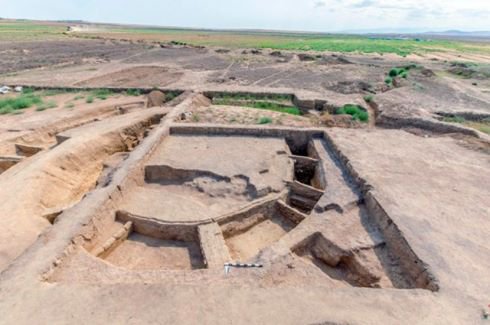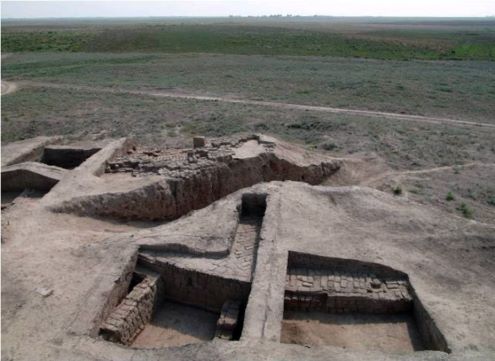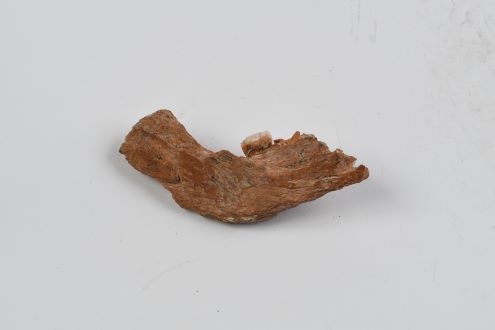The most ancient settlements in the world are in Garabagh

Azerbaijan is a very ancient place where people have settled since the first human life. Archaeological excavations and ancient buildings are the most important evidence of the antiquity of the Republic of Azerbaijan.
The area is replete with ancient monuments. Since the first period of human life, monuments have been discovered on the territory of Azerbaijan. Research has established that ancient people inhabited Azerbaijan two million years ago. One of these areas is Garabagh. The Azykh and Taghlar caves are the most important archaeological monuments of Garabagh (Karabakh).
The Azykh and Taghlar caves are two prehistoric sites of the Khojavend region of the Republic of Azerbaijan bearing exceptional value as places of dwelling of hominins since as early as 1,200,000 years ago and testimony of prehistoric fauna.
The Azykh cave (Azerbaijani: Azıx mağarası) is a unique prehistoric site located 14 km northwest of the city of Fizuli, at an altitude of 1400 meters above sea level. L It is the largest limestone cave ever found in the Caucasus and extends through maze-like passageways for nearly 600 meters. The cave comprises a total area of about 8,000 square meters. It reflects several stages of the evolution of hominins and their material culture.
The first and most important archeological excavations of the Azykh cave were carried out by Azerbaijani paleontologist Mammadali Husseynov in 1960-1982. Since 1975, Russian scientists have also been involved in the excavations and included paleozoologists, paleogeologists, paleogeomorphologists, paleontologists and specialists of other fields.
The cave contains fourteen meters of cultural deposits relating to different periods. During the archeological excavations on the southern entrance of the Azykh cave, 10 archeological layers were recorded. The oldest 10th layer of the cave is 1.2 million years old.
The archeological excavations of the cave have revealed multiple primitive work stones belonging to an early species of Homo erectus who settled in the Azykh cave around 1,200,000 years ago. These findings represent rather a river stone culture, which was named as “the Guruchai Culture”, considering that the Azykh cave is located in the Guruchai River basin. The only other known civilization equivalent to the Guruchai Culture dates back 1.5 million years and was found in the Olduvai Gorge in Tanzania.

The archeological findings made in the Azykh cave allowed making a hypothesis that people lived in the South Caucasus as early as 2 million years ago. The results of the archeological and anthropological research provide information about the types, relationships and migration routes of ancient people.
The findings of the Azykh cave also show that around 600,000 years ago another more advanced species of Homo erectus began to live in the Azykh cave, leaving the cave and returning again. 300,000 years ago, the cave was inhabited by people belonging to the Acheulean culture, referred to as “Azykhantrops” by Azerbaijani archeologists and known in the world as Homo heidelbergensis or the Heidelberg man.
Human’s lower jawbone 350,000-400,000 years old
In 1968, Mammadali Husseynov discovered a lower jawbone of a hominid of Homo heidelbergensis species (between 350,000-400,000 years old). The jawbone, with one molar totally intact and another partially broken, is believed to have belonged to a female about 18 years old. According to the French paleontologist, Lumlee, the Azikh jawbone is the fourth oldest human relic ever to be found in history and it is the oldest ever identified in the entire former Soviet Union.
Taghlar cave
Taghlar cave (Azerbaijani: Tağlar mağarası) is another archaeological site that was inhabited by prehistoric humans of the Mousterian culture during the Paleolithic. The cave is located in the Khojavend region of Azerbaijan, 3 kilometers from the Azykh cave, south of the Boyuk Taghlar village and on the left bank of the Guruchay River.
The cave was discovered during the Paleolithic archaeological expedition in 1960. Archaeological excavations resulted in discovering more than 7,000 stone tools and over 2,000 fossilized bones, along with six cultural sediment layers. The first layer belongs to the late Holocene while the rest belong to the late Pleistocene.
Pottery shards of the Middle Ages, the Bronze Age and Copper Age were found right underneath the top layer. Archeologists also discovered numerous work-pieces of tool making of red, black, brown, grey, white and other colours. It is generally accepted that the hominins lived in the Taghlar cave during the period from 64 thousand to 24 thousand years ago.
The archeological material of the Taghlar cave provides an excellent opportunity to follow the evolution of stone processing techniques, observe not only the harsh influence of traditions, but also the emergence of interesting technological innovations both in the technique of stone splitting , and in the technique of secondary finishing of tools. The main significance of the Taghlar Paleolithic site and its culture lies in the fact that it allows to establish links with the Mousterian culture of the plains to the south of the Aras River with the Mousterian cultures of the Zagros mountain system (Islamic Republic of Iran, Iraq).
Action against illegal excavations
Note that 20 percent of the lands of Azerbaijan, as well as Nagorno-Karabakh (Garabagh), were occupied by Armenia for more than 30 years. During the period of occupation, illegal excavations were carried out by Armenia in the Azykh and Taglar caves, as well as in other historical and cultural monuments.
The relevant scientific institutions of Azerbaijan took measures against illegal excavations carried out in the Azykh cave, and, based on available scientific data, exposed the illegal actions of the Armenians and their supporters both at the international and regional levels. In 2002, within the framework of the international program "INTAS-2000", 22 prominent scientists from European countries, led by Professor Henri de Lumly, visited Baku. They got acquainted with the remains of material culture discovered at multi-layered monuments such as Azykh, Taglar, Gazma and others. These scientists unanimously recognized the exceptional scientific significance of these finds for world archaeology, paleontology and paleoanthropology.

Currently, significant efforts are being made to restore and preserve historical and cultural monuments located in Garabagh liberated from occupation. One of the measures implemented is that the State Service for the Protection, Development and Restoration of Cultural Heritage under the Ministry of Culture has taken appropriate steps to create the state historical and archaeological reserve “Azykh-Taglar Cave Sites”, located in the Khojavend region.
The destroyed monuments in Karabakh and East Zangezur are being restored
According to the director of the Institute of Archaeology, Ethnography and Anthropology of ANAS, associate professor Farhad Guliyev, during the occupation there was no accurate information about the archaeological monuments in these territories: “Unfortunately, the occupation side, in addition to the destruction of people and buildings, also chose historical monuments as a target. Historical, religious and archaeological monuments of Karabakh were destroyed. According to the Ministry of Foreign Affairs of Azerbaijan, more than 700 historical monuments, 22 museums, including 100 thousand museum exhibits, 58 archaeological settlements, as well as other cultural heritage monuments were appropriated, destroyed and looted by Armenia.
In 2020, after the Azerbaijani state liberated its lands from occupation, the Ministry of Culture, together with the State Tourism Agency, registered the monuments. The “Karabakh Archaeological Expedition” has been created and archaeological excavations are being carried out in Garabagh, as well as in Eastern Zangezur. Monuments that have been destroyed for 30 years are being studied and restored. F. Guliyev notes that many valuable facts related to the history of the family of the Garabagh Khan have already been revealed. Together with our colleagues from Italy, we are trying to return the Agdam Imarat complex to its original appearance. We are restoring the palace, reflecting the historical past of the Karabakh Khanate, and also conducting archaeological excavations here and determining the location of the destroyed graves. The Armenians destroyed the graves of the Garabagh khans. “DNA samples were taken from the graves located in the tombs to identify members of the Khan family.”
Karabakh is the most optimal place for archaeological parks
Farhad Guliyev, director of the Institute of Archaeology, Ethnography and Anthropology of ANAS, said that Garabagh is the most optimal place for archaeological parks. He noted that, the authorities are considering the territory of the Garabagh economic region for the creation of such facilities.
"We suggested this project to the State Tourism Agency. We are also cooperating closely with the Ministry of Culture. The project of archaeological parks is an amazing platform to promote the monuments of Azerbaijan. We want the archaeological parks to be mainly located in districts," the institute director said.
Thus, as a result of archeological research conducted in Garabagh afor more than 130 years, hundreds of studies were conducted that allowed to obtain detailed information about its history from the Oldest Stone Age to the late Middle Ages. Complex archaeological research will be continued at a new level in free Garabagh.
Azykh and Taghlar caves were inscribed in the Tentative List
Prehistoric sites of the Azykh and Taghlar caves were inscribed in the Tentative List by the decision of the 45th session of the UNESCO World Heritage Committee held in Riyadh on September 23, 2023. Although Armenia opposed the inclusion of these ancient caves in the list, their campaign at UNESCO was unsuccessful.
By Tunjay EYVAZLI.

read by: 16982
similar news

A telephone conversation took place between the National Leader of Turkmen people, Chairman of the H
The National Leader of the Turkmen people stressed that Turkmenistan, as a close neighbor of Iran, is ready

President of Turkmenistan received advisor to Prince of Monaco
During the meeting, Joel Bouzou expressed his readiness to intensify partnership with our country

The President of Turkmenistan and the Emperor of Japan discuss future partnership
Thus, a solid package of agreements demonstrates that relations between Turkmenistan and Japan have

VIDEO: China slams US for unilateralism and economic bullying with tariffs
China announced its own 34 percent tariff rate on US goods, mirroring Trump's tariff rate for China.

The Parliamentary Assembly of the Council of Europe spring session to focus on Georgia, Türkiye, Ukr
Other debates are scheduled on foreign interference: a threat to democratic security in Europe; the interconnections
clickss





